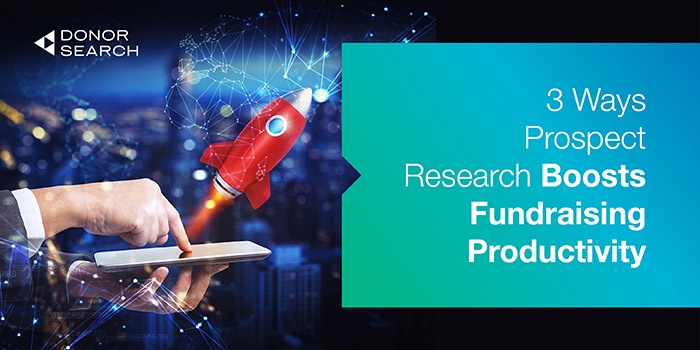
As all good fundraising managers know, raising money requires heavy-duty attention to ROI – return on investment. And the stakes go up when you’re looking for major gifts. Today’s blog is a guest post from our official partners at DonorSearch, the experts in prospect research.
Time is a valuable, scarce resource when it comes to fundraising. Your nonprofit has to put in time to investigate, qualify and build relationships with your major donor prospects, but it needs to be time well spent.
One of the best ways to ensure your team is the most productive it can be, is by incorporating prospect research into your fundraising plan.
A quick definition: prospect research is a collection of strategies used by fundraisers to determine an individual’s capacity and propensity to give to a specific organization or cause. Prospect research is largely reserved for identifying and building an outreach strategy for potential major donors.1 By the way, the size of that “major” donor is up to you – for smaller nonprofits a major gift might be as little as $1,000 while for a huge, national outfit, maybe it’s over a million.
Starting with prospect research before picking up the phone ensures fundraising productivity through:
- Developing comprehensive prospect profiles.
- Mapping connections and generating prospect lists.
- Tracking the opportunities pipeline.
These strategies start long before solicitations start and follow your fundraising team through to the end.
Ready to streamline your fundraising with prospect research? Read on to learn how it’s done!

1. Developing and utilizing comprehensive prospect profiles.
As a fundraising manager, it’s your job to make sure your team members have all the tools they need to succeed.2 Number one on that list of major gift fundraising tools are prospect profiles, the primary avenue through which prospect research facilitates productive fundraising.
Here’s the theory: you want your fundraising team to spend the most time nurturing relationships with the donors who are most willing and able to give major gifts to your specific campaign. The information you need to determine these most likely prospects is housed in prospect profiles.
Conventional prospect profiles typically contain information like:
- Basic details: Full name, nickname, birthday, and familial relations can all come in handy when crafting an effective solicitation that feels personal.
- Contact information: You need to know how to get in contact with your prospects, so make sure you have an email address, home and work address, and phone numbers on file.
- Personal history: Where your prospects went to school, what community causes they’re interested in, and what kind of investments they hold can tell you a lot about your prospect’s wealth profile and the causes they would consider supporting.
- Professional connections: If you know where your prospects work, what level position they hold, and their estimated salary, you’ll know if you can reasonably ask for a major gift or help setting up a corporate sponsorship.
- Philanthropic history: Prospects who have contributed time or money to charitable causes before are likely to do so again, especially if they’ve given to your specific cause or organization before.
This is a lot of information to keep track of, so make sure you have a plan for organizing it. Try DonorSearch’s free prospect profile templates to start, then personalize this all-purpose form to add extra sections that will help your organization narrow the field.3
Note that these categories help your fundraising team build a complete picture of your prospect’s philanthropic inclination, not just their wealth profile. Just because an individual has a lot of financial resources doesn’t mean that they will be inclined to share with your organization.
By building a comprehensive prospect profile around both wealth markers and philanthropic indicators, your fundraising team will get a much better idea of which prospects deserve the most time and how much to ask from them.
Of course, knowing what information you need isn’t the same as knowing how to find it. So how do you fill out your prospect profiles?
Depending on the size of your fundraising team and your organization’s budget, you have a few choices:
- Prospect research software services will generate prospect profiles for you. Large nonprofits will have the budget for full-service software solutions.
- The SMART Way Prospect Scorecard from Bristol Strategy Group helps you craft your ideal-funder profiles, including your best donors’ motivations for giving, their gving capacity and history, and even information about criteria you want to avoid in a donor (“big talk, no action” comes to mind). Combine the Scorecard with prospect research software and you’ve got a highly productive combination.
- Social media and other public information databases can help you manually fill out your prospect profile templates. Public information is free, as are many training resources on the internet that can teach any staff member how to find the information they need. You can get great info here, but it’s time-consuming.
Whether you’re willing to tackle prospect research in-house or want to outsource to a major software provider, Double the Donation’s ranking of the top prospect research tools can help you find the best solution for your nonprofit.4

2. Mapping connections and generating prospect lists.
An organized prospect research strategy doesn’t just help your fundraising team identify likely major donors more quickly. Prospect research also helps fundraisers identify the most effective strategy for reaching out to those prospects.
Think about it from the prospect’s point of view. Would you be more likely to respond to an email from an organization you’ve never heard of or a phone call from a business contact you’ve served with on a board before?
Prospect research helps you understand how to get that personal touch with your prospects. Some common connections are:
- Business connections: A current major donor or board member works in the same industry or company as a prospect.
- Personal connections: A current major donor or board member is related to or participated in community organizations with a prospect.
- Philanthropic connections: A current major donor or board member has contributed to a similar or the same charitable cause as a prospect.
Once you find a connection, someone on your team should reach out to the current major donor or board member to share the name of the prospect and how much they want to ask. Providing your fundraising team with these connections increases their productivity because they’re letting the current supporter, who is more likely to get a response in a shorter amount of time, do the asking.5
Prospect connections aren’t just about looking for a link between an individual prospect you’ve identified and someone in your entire network of supporters. Another way prospect research utilizes connections to expedite your fundraising is by finding connections between your cause and a giant pool of prospective donors you might never have thought about before.
A full-service prospect research software can take the inputs you provide about your organization, such as giving trends and causes you support, and generate a list of likely prospects for you to reach out to.
It’s certainly possible to find some open-source information yourself, but a prospect research software solution can do it faster, and with greater validity, further improving your fundraising productivity.
Prospect research software finds these potential donors from databases of:
- Past charitable giving in large amounts.
- Federal and state political contributions.
- Real estate and securities ownership.
- Board members of nonprofit organizations.
- Companies with corporate giving programs.
Organizations with more discrete but still vast donor pools, like universities or healthcare institutions, compare their alumni and grateful patient lists with these databases to get an even better chance at identifying a major donor.6

3. Tracking the opportunities pipeline.
Keeping comprehensive data and then using it is the only way to ensure that your solicitation actually gets better for every campaign you undertake. An organized prospect research strategy will help you keep track of where your fundraisers are spending the most time and where that time is being rewarded with major gifts.
Not many nonprofits keep the kinds of records they should, so don’t let your organization fall into the same pattern.7 Make a habit of tracking these data points in your prospect research materials, whether that means custom fields in your prospect profiles or a special feature in your prospect research software solution:
- How many prospects are you considering, and how many of that number are you spending time to build a profile for or request a profile for?
- If you’re building prospect profiles in-house, how long on average does it take? If you’re outsourcing, how fast is your software or consultant’s turnaround?
- After you create or receive a profile, how long does it take to reach out to the prospect?
- How much time is spent nurturing a relationship before a donation request is sent? Does this time depend on the prospect’s wealth profile? Could you possibly be spending more time than you need to, before that request is made (a form of ‘ask reluctance’)?
- What is the average size of a donation request, and what is the difference between the requested amount and the donation amount?
- How many prospects stop responding to messages before the donation request? How many ignore a donation request? How many never respond in the first place?
- And, the culmination of all these questions, what percentage of requests lead to donations at or above the requested amount?
The goal, of course, is to increase the percentage of requests that result in donations, and to keep on improving that percentage regularly. But to get there, you have to look at the other steps along the way.
If you find that your team is stumbling at the donation request, for instance, it might be good to refresh on some solicitation strategies.8 After all, you can’t control how much people give or if they give at all, but you can improve your chances of reaching your overall goal the more qualified people you solicit in the first place.
A well-thought-out prospect research strategy will make the first few steps of building a prospect profile and sending solicitations go more quickly, letting you bring as many prospects into the pipeline as possible.
Fundraising takes time, and it should! Building relationships with the right donors can result not just in one-time major gifts but in sustained major support for your cause.
As a fundraising manager, it’s your responsibility to make sure that the time your team puts in is worth it. Prospect research gives you that assurance.
Resources:
- https://bristolstrategygroup.com/blog/seven-strategies-to-pinpoint-high-quality-donors-1
- https://bristolstrategygroup.com/blog/4-missing-management-tools-that-derail-your-fundraising-success-part-4-of-the-revolutionizing-fundraising-series
- https://www.donorsearch.net/prospect-profile-templates/
- https://doublethedonation.com/nonprofit-software-and-resources/prospect-research-tools/
- https://bristolstrategygroup.com/blog/three-major-duties-of-great-fundraising-management-part-3-in-our-series
- https://www.donorsearch.net/prospect-research-ultimate-guide/
- https://bristolstrategygroup.com/blog/whats-missing-in-moves-management
- https://www.mobilecause.com/how-to-ask-for-donations/

